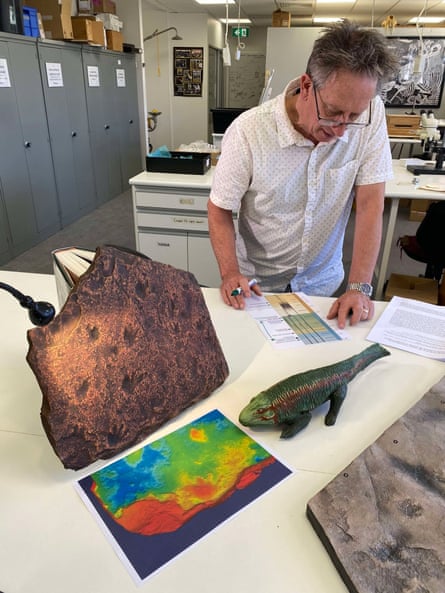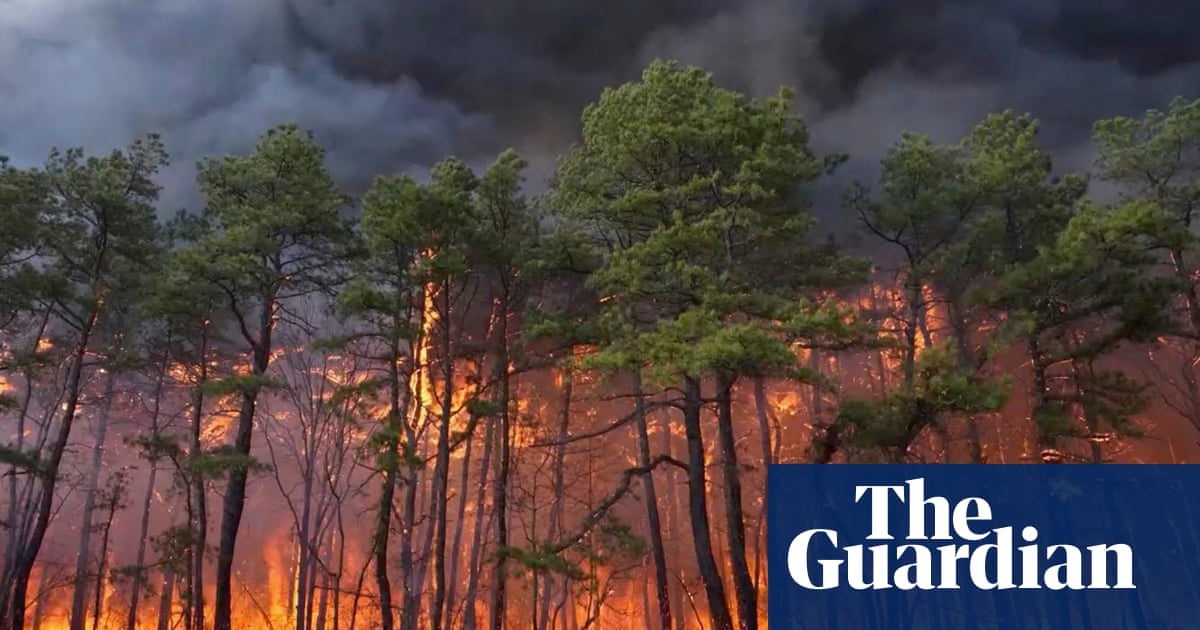Fossilised claw prints found in Australia suggest amniotes – the ancestors of reptiles, birds and mammals – evolved about 40m years earlier than thought.
The footprints, in sandstone dated 354m to 358m years old, were probably made by reptiles crossing a surface dimpled by raindrops. Researchers said the trackways represent the oldest evidence of amniotes on the planet.
“The implications are profound,” said Flinders University palaeontologist Prof John Long, lead author of the paper, published in Nature. “It’s rewriting the story of the amniotes – evolving much earlier than people had thought.”
The discovery also hinted at their emergence in the ancient southern continent of Gondwana, rather than in the northern hemisphere, he said. The trackways were much older than previous amniote fossils and tracks – from Europe and North America – dated to about 318 million years ago, as well as an earlier example identified by the authors in the course of their research.
Fossil hunters Craig Eury and John Eason found the footprints on the banks of the Broken River near the town of Mansfield, on Taungurung country, 200km north-east of Melbourne.
Long, whose connection to fossils of the area stretches back 45 years, has kept in contact with a “local band of dedicated Mansfield locals”.

He said he was “gobsmacked” when Eason sent him an email with a photograph of the find, asking: “Is this anything?”
When the photo opened on his screen, he said: “It was a beautiful set of not one but a couple of different sets of trackways criss-crossing the slab.”
An ancient rain shower had pockmarked the slab’s surface, indicating exposed ground. Later, reptilian track makers came through, leaving five-toed prints, some with imprints of claws, and scratch marks from digging.
Detailed investigations by Flinders University specialists in CT scanning and trackways, and world experts in early tetrapod (four-limbed vertebrate) tracks at Uppsala University in Sweden, confirmed the significance of the find.
The discovery pushed back the arrival of amniotes to the early carboniferous, a period named for the rich coal beds that formed in the northern hemisphere at the time, Long said.
The period was a “turning point” in the Earth’s history, he said. Oxygen levels were high and huge forests dominated the land. Swamps were full of amphibians, some up to five metres in length, and huge sharks invaded the rivers. A great diversity of animals and plants started appearing – bony fishes and seed-bearing trees.
“It was really a changing of the guard from the archaic fishes and plants that characterised the first half of the palaeozoic era, to the kind of assemblages that would dominate right through to today.”
That included the amniotes – defined by the amniotic membrane that allowed them to lay eggs or reproduce outside of water – adapted for life on the land.
“It’s a very exciting story for Australian science,” Long said. “It hints there’s a lot more work to do [and] a lot more field work. Now we’ve got the footprints we need to find the bones of these things.”
Dr Erich Fitzgerald, a senior curator of vertebrate palaeontology at Museums Victoria Research Institute, who was not involved in the study, said it was a “provocative discovery with potentially far-reaching implications”.
“What we need next is to find body fossils – bones from these rocks – that can confirm the presence of amniotes so long ago.”
Fitzgerald said the discovery of the trackway highlighted the importance of “Australia’s spectacular fossil record”, much of which was relatively understudied, and revealed the importance of collaboration between professional scientists and keen members of the public.
“This is a jaw-droppingly beautiful example of the importance of continuing to search for and collect new fossils,” he said. “Palaeontology is still in the process of unravelling the mysteries of the evolution of life … and the evolution of us.”

 5 hours ago
6
5 hours ago
6

















































